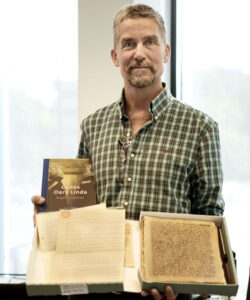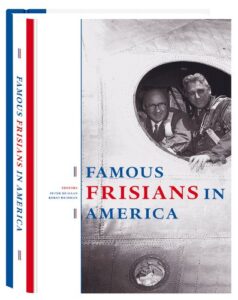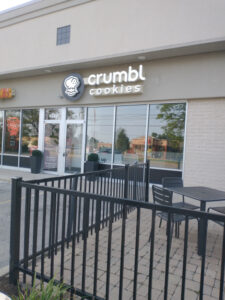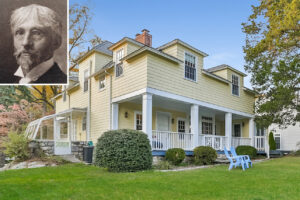









Gallery |
Sisters discover letters to their father from his friend killed during WWIIBy Elizabeth Pritchett, Fox News
|
|
Dec 25
|
December 23, 2021 – by Catherine Austin Fitts

“The work you are holding in your hands is a unique treasure.” ~ Asha Logos, foreword to Codex Oera Linda
If you live in Friesland, you fall in love with the land – with the dairy cows that give the sweetest milk, with the black Frisian horses that dazzle dressage rings with their dancing, with the endless hawks, cranes and seagulls that inhabit the shorelines, lakes and canals. And with the sheep that fill up the emerald green fields by the dykes and give birth each Easter time to babies that leap and play in the first few weeks, giving new meaning to the chant, “O lamb of God who taketh away the sins of the world.”
As much as 50% of the land in the Netherlands has been reclaimed from the sea and it teems with life, not to mention the bounty harvested from the lakes and the ocean – prawns, eels, cod and more.
Many people still speak Frisian – a softer more melodic language than Dutch. You occasionally hear references to an ancient history. Michael Pye’s book The Edge of the World describes a people whose success at surviving brutal Viking raids while sailing the North Sea, traveling and trading long distances – into the Roman Empire and across the Silk Road all the way to Asia was notable.
One local history buff says the founder of Stavoren, the sailing community where I live in the Netherlands, was a Frisian King who returned to Friesland from Persia during the time of Alexander. Also notable, according to Pye, was the Frisians ability at money and currency.
In 2019, when a group of subscribers came to Stavoren for five days, Jan Ott joined us for a long dinner by candle light. He described the history of Friesland and the Oera Linda book – an ancient manuscript written in Old Frisian discovered in the 1860’s that has inspired great debate about it’s authenticity. At the time, Jan was working on a new translation.
When I returned to the Netherlands in 2020, Jan was still plugging away on his translation to English. And he had set up a foundation to publish it. During this period, Jan introduced me to the work of Asha Logos, who has published three highly recommended videos which include introductions to and commentary on the Oera Linda book and why it is of such interest.
Conspiracy? Our Subverted History, Part 5.1 – The Oera Linda Book
Conspiracy? Our Subverted History, Part 5.2 – The Oera Linda Book
Conspiracy? Our Subverted History, Part 5.3 – The Oera Linda Book
This year Jan published his new translation to English in a beautiful hard bound book with a foreword by Asha Logos. It quickly sold out. He has now published this translation in paperback which is available at the Foundation website below.
Who shall govern? How shall we govern ourselves? Why must we be honest and keep our word? How shall we raise our children and what values are most important to teach them. These are some of the most basic and essential questions that the Oer Linda book explores. Our failure to address and answer these questions, let alone live the answers, is demonstrated in the social and financial failure that marks our current days.
Whatever its history and age, there is a great deal of truth to be found in the pages of the Oera Linda book about what it takes to create a powerful human culture – one that can endure through the centuries. If you are as interested as I am in the legal and cultural law that makes sovereign individuals and successful currencies possible, the Oera Linda book may be of interest to you.
Related reading:
Special Solari Report: Codex Oera Linda Book with Jan Ott
![]()
|
Aug 04
|
There are a few common misconceptions within the Fonda Genealogy that have arisen:
From “Early American Families“, Rev. W.A. Williams; Philadelphia, PA; 1916:
“The Rensselaer-Bowier Papers say that Douw Fonda was a Frisian, and Tacitus says that the Frisians dwelt along the coast of the North sea. They were converted to Christianity before A.D. 800. The family of Fonda was originally from the Republic of Genoa, Italy. The Marquis de Fonda was one of the leaders of a revolution in Genoa, having for its object the overturning of the aristocratic government, and putting the election of the Doge and Senate, into the hands of the people at large. The Doge (=duke) was the duke, or chief magistrate. Our ancestor was an early republican, and must have lived there, between 1339, when the first Doge was elected, and 1528 when the Dogate ceased. Baron de Fonda was unsuccessful in his attempt, and fled from the country, taking refuge in Amsterdam, Holland, whence his descendant, Jellis Douwese Fonda, emigrated to America in 1642 (1650), and had grants of land from the Dutch government, settling in or near the present city of Albany, N. Y.”
“There is a perhaps less credible tradition also, that the Fondas were Huguenots. and fled from France to Holland after the massacre of St. Bartholomew’s night, Aug. 25, 1572. There is another tradition that they fled from Spain on account of persecution or followed the Duke of Alva to Holland. It is also said that they belonged to the royal house of Spain, fled to Italy, because of religious persecution, and came later to Holland. Possibly they fled from Italy to France, and from France to Holland. The form of the family name is Latin and therefore similar in French, Italian, and Spanish, indicating the Latin origin of the family, probably In Italy. The Fondas were Dutch Reformed Protestants when they emigrated to America, and must have been among the first converts of the Reformation. Their descendants are widely scattered throughout the Union, though many are still living near the old home in Eastern N.Y.”
“The family name is taken from a deep valley in the Apennines, about 12 mi. from the city of Genoa, called Fonda, a name which means bottom, deep, foundation, etc. It is said that, in the early part of the last century, the estate was still in the possession of a branch of the family, the Count de Fonda, and there are many of the name, in the various parts of the Genoese territories.” Some of the family may have known Columbus in Genoa.”
The above is disputed in two references:
Old Dutch Families: Fonda Family (De Halve Maen Quarterly, 1945):
“The Fondas were important in up-state New York during the Colonial period and in the early development of the State. Presumably the family is of Frisian origin and one genealogist has outlined European background for the Fondas giving them a really illustrious descent. However, these stories apparently come from tradition rather than substance.”
Innes Getty Collection: Jellis Douwse Fonda (NYG&B, 1957):
“Rev. William A. Williams, in his Early American Families, gives a fanciful account of the European family of Fonda, but no references are cited, and one is free to accept or reject the entire story. Likewise, the data of the American family of Fonda is not authoritative for again, no references to source material are offered, and his conclusions are not in accord with church records. It follows that his material is mere balderdash.”
See Voyage to America Update, Italian Roots, Frisian DNA Profile and Innes Getty Collection
Per the book, “Famous Frisians in America” on pages 111-112:
“According to Van der Meer, Jelle Fonda (Jilles Douwes) must have been a son of Douwe Everts. Eagum was a very small village. But that is by no means proof that he descended from Douwe Everts. The oldest register of births, deaths and marriages, the Quotisatiekohier of 1749 (a century after Jilles Douwes), says there were 47 people living in or near the village, and 19 children under the age of 13. They included five farmers and one independent woman farmer, a widow with no profession, a schoolmaster, and three working-class families. The latter category is particularly difficult to place in a historical sense, especially when it comes to the archives dating from before the French era.

The book “Famous Frisians in America” (Haan & Huisman, 2009) has an entire chapter on the Fonda family.
There is much to be said for the suggestion that Jelle Fonda came from this group. The fact that on the occasion of his marriage he is registered as a ‘journeyman smithy’ indicates that he was a craftsman, and thus did not belong to the group made up of ’tillers of the soil’. Mention is also made of the fact that his parents gave their written consent to the marriage. This means that they could read and write. As could Jelle Fonda and his wife Hester, in view of the signatures which appear at the bottom of the document.
In the period 1632-1633, eight years before he married in Diemen, the lake known as Wargastermeer was impoldered. The primary financier of this project was the Amsterdam merchant Paulus Jansz Kley (1582-1655). Obviously he required an army of diggers and other workmen, including craftsmen. It is quite possible that Jilles Douwes was one of them. Indeed, it may well have been through the mediation of Kley that Jilles moved to Amsterdam, and he may even have helped him to get a job there. He was literate and he had a trade. Moreover, he was anxious to get ahead in the world.“
In conclusion, according to this account, here is what we know… Jilles Fonda was a journeyman smithy, who hired on to a big earthworks project near Eagum in 1632-1633 (he would have been 16-17 years old)… he then moved to Amsterdam, got married in 1641 (age 25), started a family (he became an innkeeper and blacksmith)… and then took the voyage to America in 1651 (age 35) with his young family of five. His parents have not been identified.
See Fonda DNA and History and Famous Frisians in America
Rebecca Conyne is a very common listing for the wife of Douw Jellis Fonda (1641-1700), but according to the well-respected report by Innes Getty, former Trustee and Chairman of the New York Genealogical & Biographical Society, it is incorrect. His wife is listed in that report as Rebecca Jansen (1646-1727); married in 1666 in Albany. Rebecca Conyne (nee Wemple) was the wife of Peter Conyne married in 1641.
NYG&B records of Innes Getty Collection (1957):
“In printed genealogies, other than [Williams], Douw Jellis Fonda’s wife is given as Rebecca Conyn of Leendert Philipse Conyn, but in no instance is any reference cited, nor any circumstantial evidence adduced to justify the assumption. In the list of nine children of Douw Jellis Fonda, of whom we have records, not one bears a Conyn name; Philip; Leendert; Caspar; Agniet; nor is a member of the Conyn family sponsor at any of the three baptisms recorded in the Church at Albany. Furthermore, in the list of sixty three grandchildren of Douw Jellis Fonda, not one bears a Conyn name, and in no instance is a member of the Conyn family a sponsor. Rebecca is not a Conyn name.
There is nothing of record to prove the parentage of Rebecca, wife of Douw Jellise Fonda, and the records of the Conyn family prove beyond a reasonable doubt, that she was not the daughter of Phillipse Conyn and Agneietie Caspers. The sole clue, ever so slight, is found in the Schenectady Church records. i.e.- Douw of Jellis Fonda and Rachel Winne bapt. September 1, 1700. Wit. Douw Fonda. Rebecka Janse (Rebecka, dau of Jan —?)”
“The confusion could be the result of a baptism record where Douw Fonda and Rebecca Conyne were listed together as sponsors for the baptism of Benjamin Romeyn on 8/4/1774 at the Caughnawaga DRC (parents Thomas Romeyn & Susanna Van Campen). However, these two witnesses were not husband and wife, just co-sponsors. Rebecca Conyne (nee Wemple) was the wife of Peter Conyne married on 10/23/1741. Thomas Romeyn was the first pastor of the Caughnawaga DRC, where Douw Jellis Fonda (1700-1780) and his second wife, Debora (Peggy) Wemple Veeder (Fonda) as well as Peter and Rebecca (Wemple) Conyne attended. The Douw Jellis Fonda (1641-1700) who has been attributed to have married Rebecca Conyne was the grandfather. However, his wife’s name was Rebecca Janse as established in the Innes Getty Collection.”
Ref: Innes Getty Collection: Jellis Douwse Fonda; The New York Genealogical and Biographical Society; New York, NY; 1957.
![]()
|
Jul 29
|
By Jean Bonchak – Published July 27, 2021

Crumbl Cookies in Mentor is the popular franchise’s first store to open in Northeast Ohio. (Jean Bonchak)
In a move that would make Cookie Monster happy, Crumbl Cookies is set to open its doors in Mentor (Ohio). The new shop. with its modern, minimalist interior, is set to host a grand opening on July 30 at 9662 Mentor Ave., across from Target. Currently paired with its distinctive setup is a singular product — enormous cookies created in more than 150 specialty flavors that are offered on a weekly rotating basis.
A prolific research and development department in Utah, where Crumbl Cookies originated, develops new recipes “inspired by popular flavors, foods, desserts of all kinds — from pies to cakes to candies and more,” according to the company website. A themed “Carnival” week recently tendered caramel apple, cotton candy and cinnamon fry bread varieties, along with chilled sugar and milk chocolate chip, the only staple selections on hand daily.
Andrew Fonda, who moved to Mentor from Montana to open the franchise, worked as a chemical engineer prior to specializing in the sweet treats. He said that his initial introduction to Crumbl Cookies while visiting a shop a few years ago was an enticing experience. “The open bakery… you smell the cookies, see the cookies, it was kind of a cool space,” he said. Based on a suggestion from friends, he decided to check out the Northeast Ohio market, scouting possible locations. Ultimately, Mentor fit the bill. “We really like the Mentor area and the communities surrounding it, and we chose a convenient location where people will already be out shopping,” he said. “It’s a great retail area.”

Andrew Fonda is the owner/operator of the new Crumbl Cookies set to open on July 30 in Mentor. (Jean Bonchak)
Visitors to the store will find sleek black-and-white décor accompanied by punches of pink, a confectionary color used for their streamlined, signature cookie boxes. An open-concept kitchen allows patrons to take a peek at the baking process from its beginning, blending ingredients from scratch, to the final decorated product. Orders can be placed online or in-house. Delivery is also available. Fonda noted that the bulk of business takes place on site, where customers capture the cookies’ sweet, sugary smells.
Since its inception approximately four years ago, more than 200 Crumbl Cookies stores have opened in 32 states, and several more are planned. Fonda is already working on an additional establishment for the Mayfield area. A huge social media presence definitely has helped the company’s quick and steady growth. The first TikTok video featuring its cookies drew more than a million views. And its “Unbox the Pink Box” YouTube videos, which cleverly introduce the four specialty cookies being featured for the week, typically garner thousands of looks.
A June article titled “How Crumbl Cookies took over TikTok” by Maile McCann on modernretail.com states that “The keys to the brand’s success are a rotating flavor drop model, social media savvy and a commitment to digital integration at every touchpoint.” Among the batches and varieties presented, one cookie flavor rises to the top layer of crowd favorites. “Our milk chocolate chip is a staple on our menu for a reason,” said Anna Tibbitts, the company’s public relations specialist. “It’s not only award-winning but was the first cookie on our menu when Crumbl started.”
All cookies are boxed and may be purchased separately or in four-, six- or 12-pack assortments. Smaller-sized cookies are available for catering orders only. Boxes can also be customized with a bow, sticker and note for special gift-giving. Store hours are 8 a.m. to 10 p.m. Mondays through Thursdays; 8 a.m. to midnight Fridays and Saturdays; and closed Sundays.
![]()
|
Dec 05
|
By Jennifer Gould – New York Post – December 2, 2020

The 1891-built Cos Cob home of art-world power couple Leonard (inset) and Mina Fonda Ochtman is now asking $1.4 million.
When famed Dutch-American landscape artist Leonard Ochtman moved to Connecticut in 1891 with his wife — Mina Fonda Ochtman, an accomplished American Impressionist painter in her own right — they built a house in Cos Cob and dubbed it Grayledge.
Now on the market for $1.4 million, the five-bedroom home at 35 Mianus View Terrace is where the couple became founding members of the Cos Cob Art Colony (whose famed members included Willa Cather and which helped launch NYC’s iconic Armory Show) and held classes for young artists boarding at the nearby Bush-Holley House.
The Ochtmans would also go on to become founding members of the Greenwich Society of Artists, where Leonard served as president.
Original details in the home, which was renovated in 2010, include the hardwood floors, the staircase and the solarium.
![]()